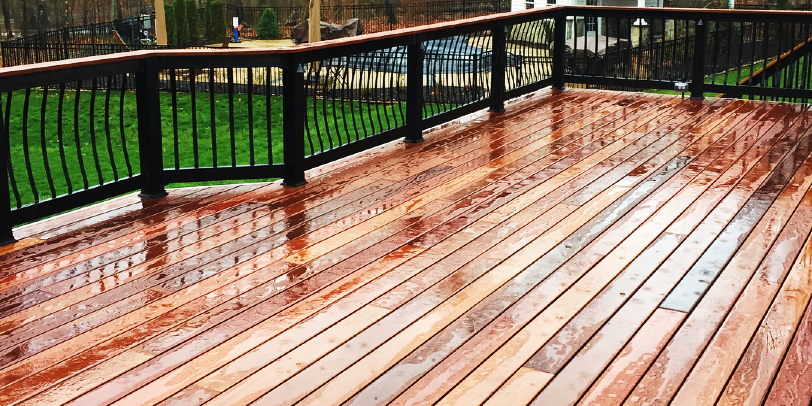Selecting the Right Stain for Your Fencing: Tips and Considerations
When it concerns improving the appearance and keeping of your fencing, selecting the appropriate tarnish is critical. With a wide array of alternatives readily available, it can be overwhelming to determine which tarnish will certainly finest match your needs. This overview will certainly provide you with suggestions and factors to consider to aid you make an educated decision. We will check out the various sorts of fence spots, variables to think about prior to choosing a discolor, ideas for preparing your fence for staining, and the differences in between oil-based and water-based stains. Furthermore, we will certainly explore selecting the right stain shade to enhance your fence and improve your outside room. By following these guidelines, you can make sure that your fencing remains secured and aesthetically pleasing for many years to find.
Understanding Different Kinds Of Fence Stains

On the various other hand, water-based stains are made from acrylic or latex and use an extra subtle shade to the wood. Water-based discolorations are simpler to clean up and have a much faster drying time compared to oil-based stains.
Selecting in between oil-based and water-based spots depends upon various elements, consisting of personal preference, the preferred look, and the degree of maintenance required. Oil-based stains are advised for fence high-traffic locations or those frequently revealed to severe climate condition. fence staining and sealing. Water-based discolorations, on the various other hand, are a prominent option for fences in houses where look and convenience of use are necessary
Comprehending the differences in between water-based and oil-based discolorations assists home owners make an educated choice when choosing the right tarnish for their fencing. Considering the certain demands of the fencing, such as its area, direct exposure to sunshine, and preferred visual, will certainly make sure that the selected discolor offers durable protection and enhances the overall beauty of the fence.
Elements to Take Into Consideration Prior To Choosing a Stain

Different kinds of wood soak up stains in different ways, resulting in varying degrees of color strength and sturdiness. Additionally, specific woods might be more susceptible to issues like rot or insect invasion, which might affect the selection of discolor to maintain the fence and shield.
The climate and climate condition in your location ought to also be taken right into account. If you reside in an area with rough winter seasons or high moisture, you may need a stain that gives additional protection against wetness and UV rays. Similarly, if your fencing is revealed to route sunlight for extended periods, a stain with UV preventions can aid prevent fading and staining.
Last but not least, it is necessary to consider your desired aesthetic. Different spots provide different colors and surfaces, enabling you to customize the appearance of your fence (fence staining). Take into consideration the total design and style of your property, in addition to any kind of neighborhood guidelines or property owner association standards that may determine the acceptable tarnish shades
Tips for Preparing Your Fencing for Discoloration
Cleaning the fencing is an important action as it removes dust, grime, and any type of previous coverings that might interfere with the discoloration process. Rub the surface gently, paying extra attention to locations with stubborn stains or mold.
After cleaning, allow the fencing to completely dry completely. deck staining. This action is essential as tarnishing a moist or wet surface area can cause poor bond and an irregular surface. Relying on the climate condition, it may take anywhere from a couple of hours to a couple of days for the fence to completely dry completely. Make certain that the fence is entirely dry before waging the discoloration process.
Before discoloration, evaluate the fencing for any type of damages, such as loose boards or nails. This item aids to open the wood pores, allowing the tarnish to pass through a lot more efficiently and evenly.

Comparing Water-Based and oil-based Stains
When choosing a tarnish for your fence, it is very important to contrast the qualities and advantages of oil-based and water-based spots. Both kinds of stains have their very own benefits and considerations, so it is vital to understand the differences in between them.
Oil-based stains are understood for their longevity and resistance to tear and use. They pass through deeply right into the wood, offering exceptional defense against the aspects. They likewise look at this website improve the all-natural beauty of the wood by highlighting its grain and structure. In addition, oil-based stains have a tendency to last longer than water-based discolorations, making them a preferred choice for fencings.
On the other hand, water-based spots are a lot more ecologically friendly and easier to cleanse up. They might not provide the same degree of security as oil-based spots, especially in extreme weather conditions.
Inevitably, the choice in between water-based and oil-based discolorations relies on your specific requirements and preferences. Think about elements such as durability, ecological effect, and ease of application when making your decision. Consulting with an expert or seeking recommendations from experts can likewise help make certain that you select the right discolor for your fence.
Picking the Right Stain Shade for Your Fencing
The choice of a suitable stain shade for your fence is an essential facet of improving its visual appeal and complementing the overall style of your exterior area (deck staining companies near me). The appropriate discolor color can change a plain, average fence right into a striking prime focus that includes depth and personality to your residential property
When choosing a tarnish color for your fencing, it is essential to take into consideration the style and style of your home. If you have a traditional or traditional design home, natural tones such as neutrals and browns can create a cozy and inviting appearance. On the various other hand, if you have a contemporary or contemporary home, you could think about opting for vibrant and lively shades that make a statement.
An additional element to take into consideration is the natural environments of your residential property. If you have a great deal of plant, a tarnish color that enhances the all-natural landscape, such as environment-friendlies or deep reds, can develop a harmonious and natural appearance.
Furthermore, it deserves considering the maintenance needed for different discolor shades. Lighter colors often tend to show dust and wear more conveniently, while darker shades can hide blemishes and require less constant touch-ups.
Inevitably, the choice of discolor shade for your fence ought to show your individual style and preferences - deck staining. Put in the time to speak with and discover different alternatives with professionals if needed, to make certain that you select the best tarnish color that enhances the elegance and appeal of your fencing
Verdict
In verdict, when it involves choosing the right discolor for your fence, it is very important to comprehend the different sorts of discolorations offered and consider aspects such as resilience and desired appearance. Preparing the fence appropriately prior to discoloration is vital for attaining optimum outcomes. In addition, contrasting water-based and oil-based discolorations can help determine the best option for your specific needs. Picking the appropriate tarnish shade can improve the overall visual appeals of your fence.
We will explore the different kinds of fencing stains, factors to take into consideration before choosing a tarnish, suggestions for preparing your fence for discoloration, and the distinctions between water-based and oil-based spots.Separating between water-based and oil-based spots is essential when recognizing different kinds of fencing stains. Water-based discolorations are simpler to cleanse up and have a quicker drying out time compared to oil-based discolorations. Additionally, oil-based discolorations have a tendency to last longer than water-based discolorations, making them a prominent selection for fencings.
In conclusion, when it comes to selecting the right tarnish for your fence, it is important to recognize the different kinds of discolorations offered and consider variables such as longevity and preferred appearance.